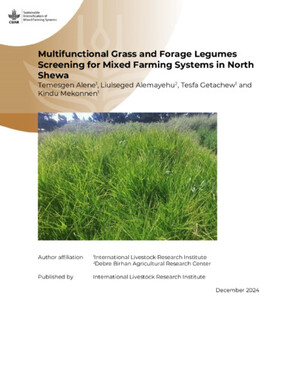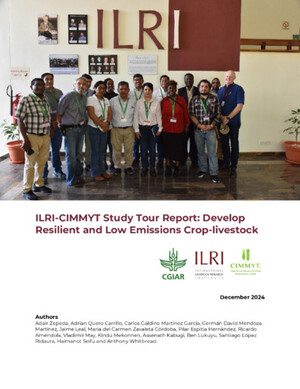
Integration of forage legumes with cereal crops. I. Effects of supplementation with graded levels of lablab hay on voluntary food intake, digestibility, milk yield and milk composition of crossbred cows fed maize-lablab stover or oats-vetch hay ad libitum
Abstract
This study examined the effect of lablab hay supplementation of crossbred cows fed forages from cereal+forage legume intercropping (maize–lablab (ML) stover or oats–vetch (OV) hay) basal diets on feed intake, apparent digestibility, milk yield and milk composition of crossbred cows. Forty eight multiparous (parity 2–4) cows approximately 60 days prepartum and mean live weight 445 S.D.±57 kg at the beginning of the experiment were used in the study. The experiment lasted 200 days each cow, covering 60 days prepartum and 140 days postpartum. Lablab hay supplementation significantly (P<0.05) increased total DM intake and DM digestibility as compared with the unsupplemented diets but there was no significant (P>0.05) difference in total DM intake among the supplemented cows. Cows fed ML stover or OV hay supplemented with lablab hay had improved rumen environment as reflected in the rates of DM, OM, N and NDF degradation greater than 0.03 (i.e. 3%) per h. The degradation parameters; a, b, c and the effective degradability (ED) were higher (P<0.001) for lablab hay supplemented diets than for ML stover or OV hay basal forages fed alone. ML stover fed alone resulted into significantly (P<0.001) higher Ca, P, and Mg intake than OV hay fed alone while K intake was significantly (P<0.05) higher with OV hay. Increasing levels of lablab hay supplementation significantly (P<0.001) increased Ca, P and Mg intakes but did not significantly (P>0.05) affect K intake in both ML stover and OV hay diets. OV hay and ML stover basal forages fed to unsupplemented crossbred cows resulted into average milk yields of 6.82 and 8.25 kg/cow per day, respectively, over a lactation period of 140 days after calving. Supplementation with lablab hay significantly (P<0.001) increased milk yield of crossbred cows fed OV hay but for ML stover based diets, supplementation was only significant (P<0.05) at the lowest level (0.4% BW) of lablab offer. For ML stover based treatments, the highest daily milk yield (9.5 kg/head) was obtained at 0.4% of body weight (BW) lablab hay supplementation, while for OV hay treatments, the highest milk yield of 9.7 kg/head was obtained at 1.2% BW lablab hay supplementation. Mean concentrations of milk fat, protein and total solids were similar for both ML stover and OV hay diets fed alone but lablab hay supplementation did not significantly affect the concentration of milk components of cows fed both forages. It was concluded that for optimum milk production from crossbred cows fed ML stover and OV hay basal diets, supplementation should be at 0.52 and 0.85% of BW level of lablab hay, respectively. The lack of response to higher levels of lablab hay supplement despite the increased protein intake was interpreted as resulting from a deficit of dietary energy.
Citation
Livestock Production Science;79(2-3): 193-212










